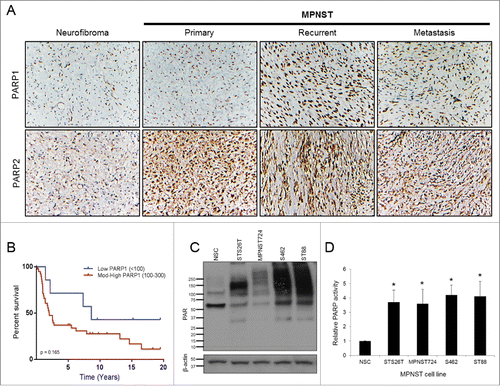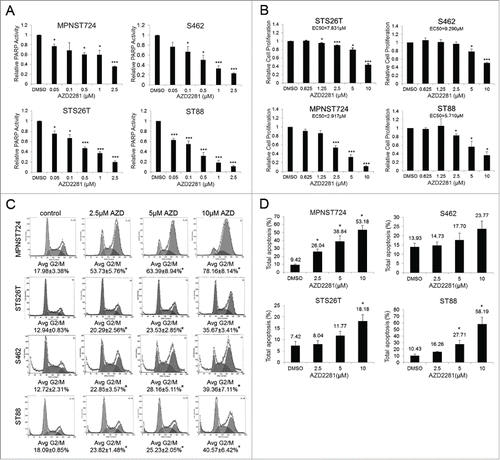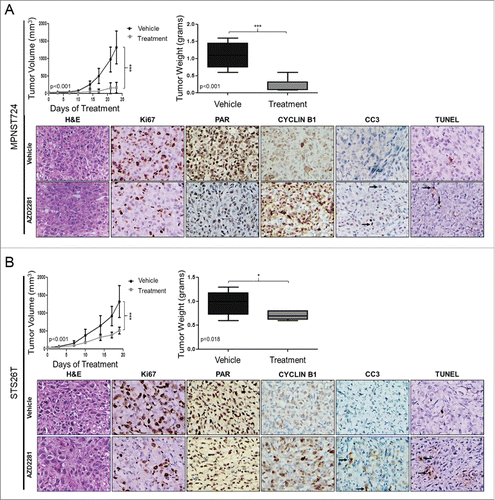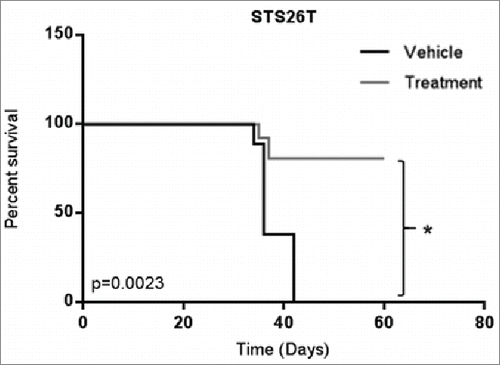Figures & data
Figure 1. PARP expression and activity is enhanced in MPNST cell lines compared to normal Schwann cells. (A) MPNST TMA stained for PARP1 and PARP2. Images were captured at 200× magnification. (B) PARP1 staining correlated to patient outcomes. (C) PAR immunoblot of MPNST cell panel and normal Schwann cells. (D) Endogenous PARP activity in untreated MPNST cells and normal Schwann cells (n = 4). Error bars represent standard error of the mean; (*= p < 0.05).

Table 1. Mean expression of PARP1 and PARP2 combined score (0–300) and percentage of tumors with positive staining in neurofibroma and MPNST.
Figure 2. AZD2281 significantly inhibits MPNST cell growth in vitro. (A) A panel of MPNST cell lines were pretreated for 24 hours with AZD2281 and subjected to a modified PARP activity assay (26T, ST88, and 462 n = 3; 724 n = 2). (B) MPNST cell lines were treated for 96 hours with AZD2281 and cell proliferation was assessed by MTS assay (26T, 724, and 462 n = 3; ST88 n = 4). (C) PI FACS analysis after 24 hour treatment with AZD2281 in MPNST cell lines (26T and ST88 n = 3; 724 and 462 n = 4). (D) Annexin V-FITC/PI FACS analysis after 96 hour AZD2281 treatment in MPNST cell lines (n = 3). Error bars represent standard error of the mean; (*=p < 0.05; ***=p < 0.001).

Figure 3. AZD2281 significantly inhibits MPNST local tumor growth in vivo. (A) Seventeen female hairless SCID mice were injected with 2 × 106 MPNST724 cells and treated with AZD2281 for 23 d. Treatment groups included vehicle (10% HPCB, 10% DMSO, and PBS) (n = 9) and 50 mg/kg/day AZD2281 (n = 8). Tumor volume and weight were assessed. Tumor samples stained for Ki67, PAR, cyclin B1, CC3, and TUNEL. (B) Mouse experiment proceeded as above excepting 16 mice (n = 8 per treatment group) were injected with STS26T cells and treated with AZD2281 for 19 d. Original photos were captured at 400× magnification. Error bars represent standard deviation; (*=p < 0.05; ***=p < 0.001).

Figure 4. AZD2281 significantly improves survival in an in vivo model of metastatic MPNST. Female hairless SCID mice were injected with STS26T cells in the tail vein and treated with AZD2281 for 60 d. Treatment groups included vehicle (10% HPCB, 10% DMSO, and PBS) and 50 mg/kg/day AZD2281. (* = p<0.05).

